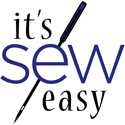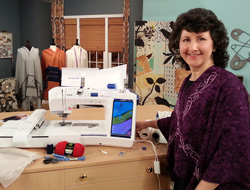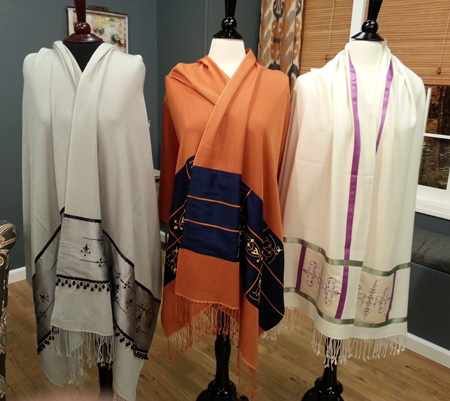
Embroider Beautiful Bobbin Work on a Pashmina Scarf – Joanne Banko
You can embroider or stitch beautiful bobbin work using a simple straight stitch. Create motifs using special bobbin work embroidery designs or simply draw an outline on fabric and manually stitch the motif using a straight stitch. Either way, the tips and techniques presented in this project will guide you as you experiment with beautiful bobbin work. The embellished pashmina wrap featured in this project is randomly embroidered with built in bobbin work embroidery motifs from the Brother Quattro® machine.
Materials and Supplies:
- Purchased blank pashmina scarf. See resource list for details.
Note: As an alternative you can make a scarf from lightweight wool or wool blend fabric.
- Good quality polyester sewing thread for the needle.
- Novelty thread for the bobbin, such as YLI Brand serger threads (Success Serger Yarn, Ribbon Floss, Designer 7, and Candelight Metallic). Also consider using super fine yarn, 2mm soft silk ribbon and perle cotton No.5.Threads must be smooth and not easily separated. Ordinary embroidery floss is not suitable. Be sure to test all threads before using them for your project.
Note: I used Designer 7 in this project.
- Large eyed tapestry needle for feeding thread tail to wrong side.
- Low tack tape to keep thread tails from tangling.
- Stabilizer appropriate for fabric – Recommended types include wash away, heat away, and easy tear paper types.
Note: It can be difficult to remove some stabilizers from an intricate design motif. If you cannot wash or easily tear away the stabilizer, be sure to select motifs that allow for easy removal of the stabilizer.
- Secondary bobbin case adjusted for heavy novelty threads. The bobbin tension must be adjusted so the featured thread flows smoothly. Note: Some machines have a bobbin work kit included as it is for the Brother Quattro used in this project. You may find a bobbin work bobbin case available as an accessory option. For example the optional Brother Bobbin Work Kit works with many Brother model machines.
Instructions for Creating Bobbin Work:
To stitch bobbin work embroidery designs on the Brother Quattro, set up the machine as follows:
Step 1.Select Ordinary Embroidery mode. Set up machine for bobbin work, using your chosen bobbin thread. NOTE: See Tips and Techniques for bobbin work set up. Select motif No.3 from built in bobbin work designs. See Figure #1.
Figure #1
    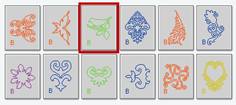
Step 2.Prior to working on your project it is a good idea to test your design on a fabric that is similar. When finished, your bobbin work should look smooth and relatively even. If you are using matching thread in the needle the prominent thread on the bobbin side should be your decorative bobbin thread. Adjust the upper (needle) tension or the bobbin tension if necessary to achieve desired results. The Brother bobbin work kit comes with a manual describing the details for adjustments as well as additional helpful tips. Layer your fabric or pashmina wrap with the stabilizer against the wrong side. Using the 5” X 7” hoop, hoop the piece having the wrong side facing up, and the right side of the fabric against the throat plate. Place hoop on machine. Increase the upper tension. Generally, you would use a range between 6-8. NOTE: It is important that the tie off and cutter function are both turned off. Rotate the design if desired. Advance to the first stitch in the design. Send the needle down and then tug on the thread up to bring the bobbin thread to the top side. See Figure #2.
Figure #2
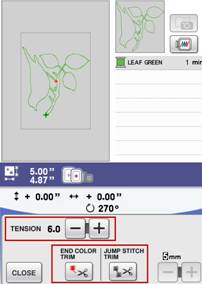 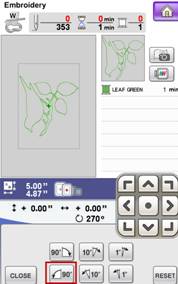 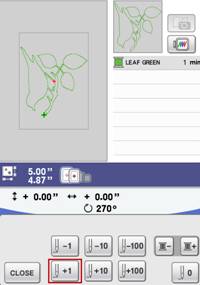
Step 3.Advance to the first stitch in the design. Send the needle down and then tug on the thread up to bring the bobbin thread to the top side. Tape the thread tails to the side. Stitch the design. When finished, raise the needle, raise the presser foot, and remove the hoop from the machine. Cut thread tails leaving several extra inches. Tie off the beginning threads, knotting them by hand. Pull the ending bobbin thread to the wrong side by threading it through a tapestry needle. Tie off as you did for the first. To further anchor the threads, treat with seam sealant, weave the tails under previous stitches, or consider using both methods.
Note: On most fabrics seam sealant dries clear. Always test seam sealant in an inconspicuous area to see if it leaves residue on your fabric.
Step 4.Embroider additional motifs randomly across the fabric. I used a combination of Motif No.3 and Motif No.1 from the built in patterns. Remove stabilizer.
Admire your beautiful bobbin work!
Tips and Techniques for Successful Bobbin Work:
- Purchase a special bobbin work kit or a secondary ordinary bobbin case for your machine model. If using an ordinary bobbin case you will need to loosen the tension to allow various novelty threads to flow smoothly through the tension disk. This will require some experimentation. Loosen a very small amount at a time and then test your straight stitching “upside down”. Good results are achieved when your bobbin work looks smooth and relatively even. If you are using matching thread in the needle the prominent thread should be your bobbin thread. If your needle thread is prominent try tightening the upper tension a bit at a time. If your bobbin thread does not flow smoothly you will need to loosen the tension on the bobbin case. Most often it is necessary to “tweak” both top and bobbin tensions a bit at a time. Using matching thread in the needle allows for a better look on the bobbin side. Try not to be too fussy. Bobbin work is designed to have a textured look and does not have to be perfectly balanced. Various threads will produce different results.
- For embroidery machines without built in bobbin work designs, explore your options for purchasing designs digitized specifically for bobbin work.
- For machines without embroidery capability, explore your options for creating bobbin work with free motion stitching. You can also trace a simple outline and stitch the motif manually using a medium length straight stitch.
- Hand wind thick threads or threads that easily twist.
- Clip or otherwise secure bobbins after winding by hand to prevent unraveling of thread. Wind several bobbins if you are stitching more than one design. Depending on the design and the thread, you may be better off beginning with a full bobbin for each new motif.
Resources:
- For additional embellishment ideas and bobbin work projects visit the project and tutorial section at Brothersews.com.
- Visit your local sewing machine dealer for serger threads and special machine accessories.
- Novelty Serger threads also available atwww.Ylicorp.com.
- Pashmina/Silk Wrap: I used a 2 ply wool/silk pashmina wrap from The Pashmina Store, available from www.thepashminastore.com.
- Please visit Joanne Banko at her website www.letsgosew.com. See more embellished pashminas and embroidered wrap garments in her book, Wrapped In Embroidery by Joanne Banko, www.wrappedinembroidery.com .
Sewing Machine Featured in this Segment:
Brother Quattro 3 – 6750D - Sewing, Quilting, Crafting and Embroidery Sewing Machine
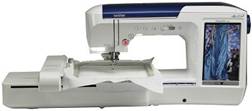
|
